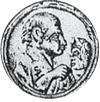L’écran comme vecteur de la mémoire du théâtre
DOI:
https://doi.org/10.46522/S.2021.01.14Keywords:
ancient theatre, actorAbstract
The Screen as Vector of the Memory of Theatre
This article shows how Ivo van Hove’s performance Les Damnés, based on Visconti’s film, reuses material from ancient Greek theatre. The stage director introduces the cinematographic idiom with the use of the camera in order to keep the continuity with Visconti’s film. Members of the Von Essenbeck family are characters bearing resemblance to Agamemnon, Clytemnestra, Orestes, Aegisthus and Creusa, Jason’s new wife. Their actions can be understood and magnified by the simultaneous reading of the Greek tragedies (Oresteia, Orestes, Electra, Medea). Thus, we establish the characters’ ancient nature, which gives them an archetypal consistency, while, by the use of the camera, the stage deepens its insight on them, focusing on the details of their faces and the actors’ work.
References
DUPONT, Florence, 2001. L’Insignifiance tragique, Paris : Gallimard.
JUDET DE LA COMBE, Pierre, 2017. Homère, Paris : Gallimard, (« Coll. folio »).
Les Damnés, d’après le scénario de Luchino Visconti, Nicola Badalucco et Enrico Medioli, 2016. Avignon : Cour d’honneur du Palais des papes [mise en scène : Ivo van Hove]
Les Damnés, 2017 [captation du spectacle, mise en scène : Ivo van Hove]. Réalisateur : Don KENT. France : coproduction Comédie Française, La compagnie des Indes.
NIKIFORAKI, Despoina, 2015. Emergences de la théâtralité, Toulouse : Presses Universitaires du Midi.
NIKIFORAKI, Despoina, 2012. La Médée d’Apollonios de Rhodes versus la Médée d’Euripide : l’héroïne polypharmakos et sa face amoureuse, Folia Electronica Classica, 24, [consulté le 21/08/2021]. Disponible à l’adresse : http://bcs.fltr.ucl.ac.be/FE/24/Apollonios.pdf.
Downloads
Published
How to Cite
Issue
Section
License

This work is licensed under a Creative Commons Attribution 4.0 International License.
CC-BY permits any use, reproduction, distribution, self-archiving and citation of the work as long as the authors are credited. The complete bibliographical data of Symbolon Journal must also be indicated, which you can find in the How to cite section on this page. If possible, please also place a link leading to the original publication.
Copyright of the paper belongs to the author(s).








